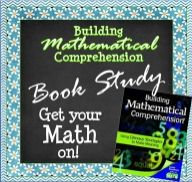When the author wrote that every student is a Mathematical Language Learner I could not have agreed more! Just thinking about all the different activities and accommodations I make for my ELL kiddos, that's exactly what I should do for my math group! They need multiple exposures, visual representations, etc. Math is like a whole new language if you think about it! Add on that some of our math vocabulary has multiple meanings, but if the kids try to use their prior knowledge to decode the words they will get so confused. Two examples: feet and yard. When kids hear those words they think of a body part or their "front/back yard," not twelve inches and 36 inches. So what can we do to help them learn this "new language" you might ask?
The first thing you need to do is compile a list of your math vocabulary. Now I'm not just talking about what the chapter tells you in bold words. Look at your state standards or the Common Core practices, look at the word problems and find words that kids will need to know to become successful mathematicians. The textbook can be very helpful but it is not the end all be all and you want to make sure you're words align with your standards. This would be great to do with your team during a PLC (does anyone else have those???).
Once you have your list of vocabulary words there are many different ways the author gives you to help promote their vocabulary fluency inside and outside of the classroom!
1. Letter to parents asking for their support at home with the new words. I really like this idea because as much as we might complain about parent involvement sometimes, most of them really do want to be helpful they just don't know how or what we are learning about. By sending a letter home for every unit and telling them the words and how they can incorporate it at home can be huge to our student's learning! You can even include a challenge (Math Hunt) and have them find these words/examples in the real world and bring them in for extra credit on the test or make a big collage for your classroom.
2. Math Word Wall - I love this idea but I think I would want it to look a little different from our regular word wall. This one would have pictures and examples, etc. but I just can't think of how I would want it to look, especially with the limited space... Anyone else do this? What does your Math Word Wall look like?
3. Graphic Organizers - the same ones you use for your reading vocabulary except now you will use number representations.
Frayer Diagram
Venn Diagram
"These Are.../These Are Not..." Chart
Matrix or Semantic Features
Analysis Grid
Concept Map
Vocabulary Charades
Make My Day (Students have answer cards and you call out "If you have 7 + 9, make my day." The person with 16 will come up and bring you their card. Continue this until all cards are gone.)
I Have, Who Has
Math Hunt (explain above)
Talk a Mile a Minute (like Taboo or Pyramid but with math terms)
5. Literature Links - you all know how I feel about children's literature in mini-lessons... LOVE! If you head on back to my post on chapter 1 there is a great link that will take you to a website that has different picture books for each math unit! One thing I really like about using children's literature in my lessons is that not only can it give the kids a real world application but it gives them a common experience. Very rarely do they all have the exact same background experiences, but with a read aloud they will and you now can go back and reference the book in small groups and what not.
Whew that was long! Thanks for sticking with me through that lengthy post :o) I hope you got some good ideas that will help you embed your math vocabulary into your lessons. Check back on Friday as I will be hosting Chapter 3 of the Building Mathematical Comprehension Book Study. It's all about Making Mathematical Connections!




One of the issues I had with my parents last year was that they didn't know how to help their children with their homework. Many of my parents went to school in different countries and were taught a completely different method. I like your idea of a parent letter here cause you (and me :)) could have a diagram or something of how to teach some of those harder skills (mainly multiplying 2 digit x 2 digit numbers and long division). Thanks for the suggestions!
ReplyDeleteAngie
Teaching With Class
What a great post! Thanks for the great detail.
ReplyDeleteI have always loved, loved loved, teaching math. I hope you will too!
Adding this book to my "Must Read" list!
Elizabeth
Hodges Herald
I'm adding this book to my list as well! Come and link with me: anything you buy, sell, find, love, or make with dollar items. I would love see to see what you share! http://www.ateacherwithoutaclass.com/2013/06/dollar-days-linky-2.html
ReplyDeleteSabra,
ReplyDeleteThis is a great post. I really like how you explained all the main ideas from the chapter and expanded on them with your own ideas. I want to have a math word wall next year as well and am busy planning it in my head.
Beth
Thinking of Teaching